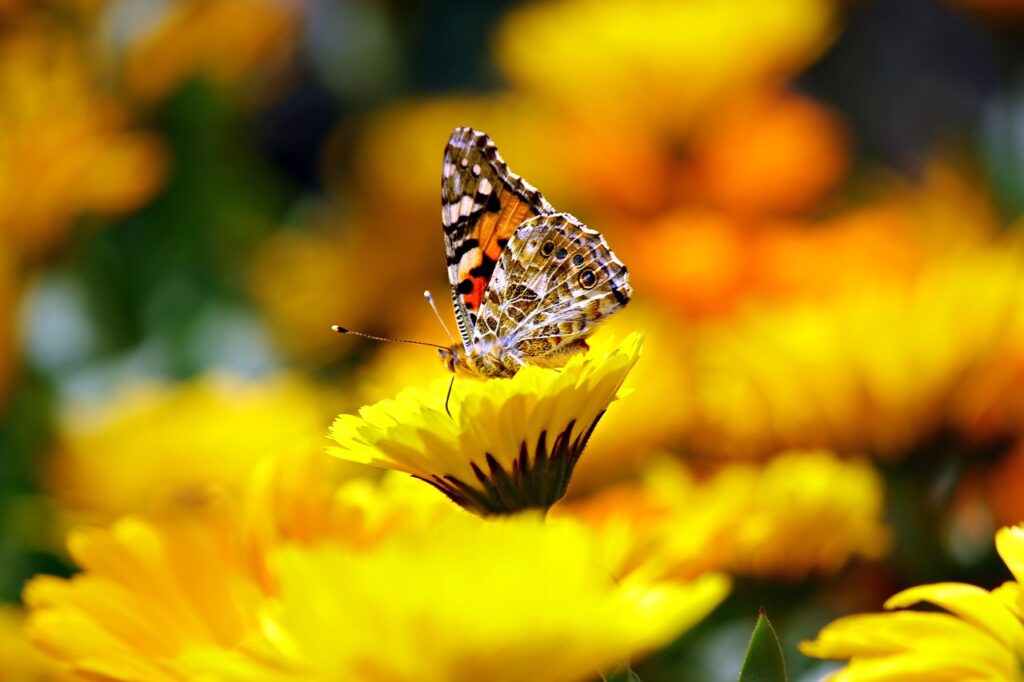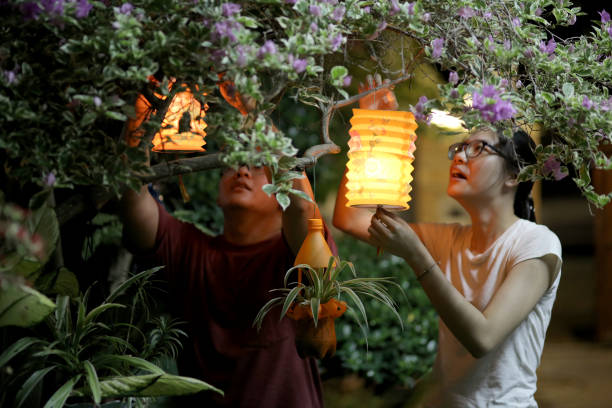Gardening is where the soul finds its secret heaven, amidst the petals and leaves. The place where we uncover the magic of growth and the poetry of life. In the garden, time slows down, and worries are removed at the garden gate. Here, we find comfort, beauty, and the evergreen embrace of Mother Nature.
In the garden, we not only cultivate plants but also cultivate a sense of peace and wonder. It’s a reminder that, amid our modern, fast-paced lives, there’s profound beauty in slowing down and tending to the earth. Gardening is an invitation to be in harmony with the natural world, to see the miracles of growth, and to find joy in the simplicity of life.
Blossom by Blossom: Exploring the World of Gardening Ideas” is a captivating journey into the realm of horticulture, where you’ll discover the secrets of creating butterfly-friendly plants, rock garden wonder ideas, gardening at home, DIY garden lights ideas, and benefits of gardening on the rooftop.
How can we do Gardening at Home?
Gardening at home can be a fulfilling and rewarding hobby that allows you to connect with nature, beautify your surroundings, and even you will grow your own food. Here are some steps that get you started with gardening at home:
- Choose a Suitable Location:
Identify a suitable place for your garden. Most plants require at least 6-8 hours of sunlight per day, so choose a site that receives adequate sunlight.
- Determine Your Garden Type:
Decide on the type of garden you want to make. You can have a flower garden, vegetable garden, container garden, or a combination of these. Your choice will impact the plants you select and how you arrange them.
- Prepare the Soil:
To determine the pH and nutrient levels test your soil. Amend the soil as needed with compost, organic matter, or soil conditioners to improve its fertility and drainage.
- Plan Your Garden:
Sketch a rough layout of your garden, considering the size and shape of your planting beds, pathways, and any garden structures like raised beds. This plan will help you fantasize about your garden’s design.
- Choose Your Plants:
Select plants that are suitable for your climate, soil type, and the level of supervision you can provide. Consider factors like the size of the plants, their water requirements, and compatibility with neighboring plants.
- Plant Your Garden:
Follow planting guidelines precise to each plant. Dig holes of the proper depth, place the plants, and water them well. Be mindful of spacing to allow for growth and air circulation.
- Watering:
Set a watering schedule based on your plants’ needs. Use mulching to help retain moisture and reduce weeds.
- Fertilization:
Feed your plants with appropriate fertilizers or organic compost, following the recommended guidelines for each type of plant.
- Pest and Disease Management:
Implement preventive measures like companion planting or using organic pest control methods when required.
- Pruning and Maintenance:
Prune your plants as required to promote healthy growth and remove dead or diseased branches. Regularly examine your garden for signs of problems and address them.
- Enjoy Your Garden:
Take time to appreciate the beauty of your garden. Harvest fruits and vegetables when they are ripe, cut flowers for bouquets, and simply relax in the green space.
Gardening is a continuous learning process, so don’t be discouraged by failures. Gardening at home can be deeply satisfying and therapeutic, allowing you to connect with nature and create a personal oasis in your backyard.
Butterfly-Friendly Plants

Creating a garden that welcomes butterflies is like opening a door to a world of magic and natural beauty. Butterfly-friendly plants attract and provide essential resources for butterflies, including nectar for adult butterflies to feed on and host plants for caterpillars to lay their eggs and provide food for their young. Here are some common plants that you can consider for your garden:
- Milkweed (Asclepias spp.):
This is the primary host plant for butterflies. It gives food to the monarch caterpillars and nectar for adult butterflies.
- Butterfly Bush (Buddleia spp.):
As the name indicates, this plant is a favorite among butterflies for its abundant nectar-rich flowers.
- Lantana (Lantana spp.):
Lantana produces clusters of colorful flowers that are highly attractive to butterflies.
- Coneflowers (Echinacea spp.):
These daisy-like flowers are very beautiful and provide nectar for a variety of butterfly species.
- Zinnias (Zinnia spp.):
It comes in various colors and sizes and is known for attracting butterflies and other pollinators.
- Verbena (Verbena spp.):
Verbena’s long-lasting blooms are a great source of nectar and are loved by butterflies.
- Pentas (Pentas lanceolata):
Pentas is often called the “butterfly flower” due to its strong appeal to butterflies.
- Marigolds (Tagetes spp.):
These cheerful flowers attract butterflies and can help control some garden pests.
- Joe-Pye Weed (Eutrochium spp.):
This tall perennial is a magnet for butterfly species and provides nectar late into the season.
- Fennel (Foeniculum vulgare):
Fennel is a host plant for swallowtail butterflies, and its yellow flowers attract many other species.
- Parsley (Petroselinum crispum):
Like fennel, parsley is a host plant for butterflies and can attract them to your garden.
- Dill (Anethum graveolens):
Dill is another host plant for swallowtail butterflies, and its delicate flowers are appealing to many butterflies.
Remember that different butterfly species have specific plant preferences, so incorporating a variety of these plants into your garden can attract a mixed range of butterflies. Further, avoiding the use of pesticides in your garden will help protect both butterflies and their caterpillars from harm.
Rock Garden Wonder Ideas
Creating a charming rock garden at home can transform your outdoor space into a peaceful and visually enchanting oasis. Here are some rock garden ideas to uplift your project:
- Slope-Side Haven:
If you have a sloping area in your yard, consider terracing it with rocks to create a rock garden. Plant low-maintenance perennials, succulents, and ground cover on each level to prevent soil erosion and add interest.
- Desert Dream:
Simulate the arid beauty of a desert landscape by using a combination of large stones and drought-tolerant plants like agave, yucca, and cacti. This style works well in regions with hot & dry climates.
- Alpine Retreat:
Craft a rock garden of the alpine landscapes with low-growing plants like alpine sedums and dwarf conifers. Add small rocks, pebbles, and even a tiny mountain stream using gravel to complete the look.
- English Cottage Charm:
Design a cozy rock garden with a cottage garden feel by mixing a variety of colorful perennials like delphiniums and daisies among the rocks. Add a rustic bench or a weathered wooden gate to enhance the out-of-date vibe.
- Fairy Garden Fantasy:
Create a whimsical rock garden that invites fairies and magical creatures by incorporating miniature plants like dwarf hostas, and tiny ferns. Add miniature fairy houses and tiny bridges for a touch of enchantment.
- Wildlife Habitat:
Attract butterflies, bees, and other pollinators by planting nectar-rich flowers and adding a small water source like a shallow birdbath for butterflies.
Remember to choose rocks that match the style of your garden and the plants you plan to retain. Proper drainage is crucial for rock gardens, so confirm the soil beneath the rocks is well-draining. With a little creativity and care, your rock garden can become a lovely focal point in your outdoor space.
DIY Garden Lighting Ideas

Certainly! Here are some DIY gardening lights ideas to consider:
- Mason Jar Lanterns:
Fill mason jars with battery-operated fairy or tea lights. Hang them from tree branches or place them on tabletops for a warm and rustic glow.
- Solar-Powered Path Lights:
Establish solar-powered pathway lights along garden walkways to illuminate paths and enhance safety.
- String Lights:
Drape string lights along walls, or trees for a magical ambiance. Use different styles, such as globe lights or Edison bulbs, to create various effects.
- DIY Tin Can Lanterns:
Create unique lanterns by sticking decorative patterns into empty tin cans.
- LED Rope Lights:
Outline garden beds or highlight architectural features with flexible LED lights. They are energy-efficient and universal.
- Upcycled Chandeliers:
Repurpose old chandeliers by removing the electrical components and replacing them with candles or solar lights for a luxury garden focal point.
- Fire Pit Ambiance:
Establish a fire pit in your garden area for both warmth and ambient lighting. Enjoy the crackling flames and the relaxing atmosphere it provides.
- Solar-Powered Mason Jar Lid Lights:
Attach solar-powered garden light lids to mason jars filled with decorative elements like colored sand. Place them on tabletops or hang them for an attractive glow.
These DIY garden lighting ideas can add a touch of magic and elegance to your outdoor space while allowing you to customize your garden’s ambiance.
Rooftop Garden Benefits: Beauty and Efficiency
The benefits of gardening on the rooftop are the following to consider:
- Utilizes Unused Space:
Rooftop gardens make use of unused rooftop areas, transforming them into useful and green spaces.
- Environmental Benefits:
They help improve air quality by catching carbon dioxide and releasing oxygen, contributing to cleaner urban environments.
- Energy Efficiency:
Rooftop gardens provide natural insulation, reducing indoor heating and cooling needs, which can lead to energy savings.
- Stormwater Management:
They absorb rainwater, reducing the risk of urban flooding and helping to manage stormwater runoff.
- Biodiversity:
Rooftop gardens create habitats for birds, insects, and beneficial pollinators, encouraging urban biodiversity.
- Urban Heat Island Mitigation:
They fight the urban heat island effect by cooling rooftops and surrounding areas, making cities more comfortable during hot weather.
- Aesthetic Appeal:
Rooftop gardens enhance the visual appeal of buildings, providing peaceful retreats for residents and visitors.
- Food Production:
Some rooftop gardens are used for growing fruits, vegetables, and herbs.
- Mental Health Benefits:
Spending time in rooftop gardens can reduce stress, improve mental health, and create a sense of calm.
